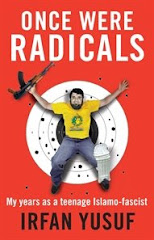The following was first published on the Aussie Mossie blog on 22 May 2005.
Muslims come in all shapes and sizes, colours and flavours. They speak all different languages at home. And like all major religions, Muslims have different denominations with different understandings of Islam.
Yet regardless of colour or sect or belief, Muslims all become equally upset when neo-Conservative commentators and shock jocks speak with ignorance about Islam and Muslims. Usually the ill speech consists of the presentation of a huge conspiracy that Muslims are conspiring to destroy western civilisation. The ill speech is often made to sound less defamatory by pretending that a clear distinction exists between “Islamists” and the “moderate” Muslims.
Daniel Pipes is a great supporter of the notion that “Islamists” are evil and must be destroyed. He estimates that 10-15% of Muslims are “Islamist”. In a community of 1 billion people, that means that at least 100 million of these are eligible for elimination.
Hitler killed 6 million Jews. Daniel Pipes allegedly wants to see 100 million Muslims eliminated. Who is more dangerous? Or is that an unfair question to ask?
Of course, what hate-mongers like Mr Pipes do not focus on is the enormous diversity of faith and culture that exists within Muslim communities. I witnessed that diversity first-hand on the evening of 21 May 2005 when I attended a cultural night organised by the Ismaili Shia community in Sydney.
The Ismailis are a small sect that branched off from the mainstream varieties of shia (being the ithna ashariyya and the zaydiyya). The spiritual leader of the branch of Ismailis I met is known as the Agha Khan. Hence, this branch are often described as ‘Agha Khanis’.
The bulk of the Ismaili Muslims I met that night hailed from Gujrat in the Indian sub-Continent. They form a large minority within a broader Ismaili community that find their homes in Central Asia, China, the Middle East and Africa. Most of my Indian Ismaili friends travelled widely, and many settled in Pakistan following partition in 1947. Many speak Urdu and Gujrati, but almost all speak fluent English.
The Agha Khani community are extremely organised, and have a very slick public relations machine. Many of our allegedly mainstream Muslim organisations could learn a lot from this small Ismaili branch about building bridges with their host communities and communicating their contributions and achievements.
The night commenced with drinks and tandoori chicken. I felt right at home in the company of ‘desi’ (i.e. from the Indian sub-Continent) people. There were plenty of saris floating around, and I even noticed mums eyeing me as a marriage prospect for some female relative.
How on earth did they know I was single? I pondered on this point over a samosa before remembering a common refrain of my own desi mum: "Hindustani aur Pakistani ma'o ko sab kuch patha lag jaatha hai" (more or less translated as "Indian and Pakistani mums have a unique system of matrimonial telepathic radar").
The Communications & Publications Director of the Australia/New Zealand wing of the international Ismaili community addressed a mixed crowd of politicians, civic leaders and other people of actual and supposed influence. He cited the verse from the Quran in which God says that He created us from one male and one female, then making us into tribes and nations so that we may come to know each other, not hate each other.
The Director went onto mention the Clash of Civilisations thesis of Samuel Huntington. He said that in reality, civilisations can only enrich each other, and that a clash of civilisations was impossible. Sadly, what was possible was a clash of different forms of ignorance. And so it is when ignorance spreads within and between communities that conflicts begin.
It was not hard to read between the lines of the Director’s message. On the one hand, he was signalling that Ismailis were mainstream Muslims and mainstream Australians, and that most Muslims are of this description. On the other hand, he was telling his audience (which included a close Parliamentary colleague of the Prime Minister) that Muslims are not a monolith and are not to be treated as the enemy.
His message is hopefully still ringing in the ears of the Mayor of Baulkham Hills Shire (where the function was being held). The Shire Council had recently shown its commitment to the Muslim communities by refusing to allow a development application from a Muslim to build a small inconspicuous prayer facility on his property. The property was located in the heart of an industrial zone and on a main road, well away from residential areas where parking and noise may have affected residents.
The Director’s message was later expressed to me in more strident language by some young Ismailis I met. They are highly educated, articulate young men and women who had travelled far and wide. Their view of the world was far more realistic than so many Muslim young people from mainstream sunni and shia communities (many of whom rarely venture outside of the Muslim ‘ghettos’ of south western Sydney).
Words © 2005-10 Irfan Yusuf









